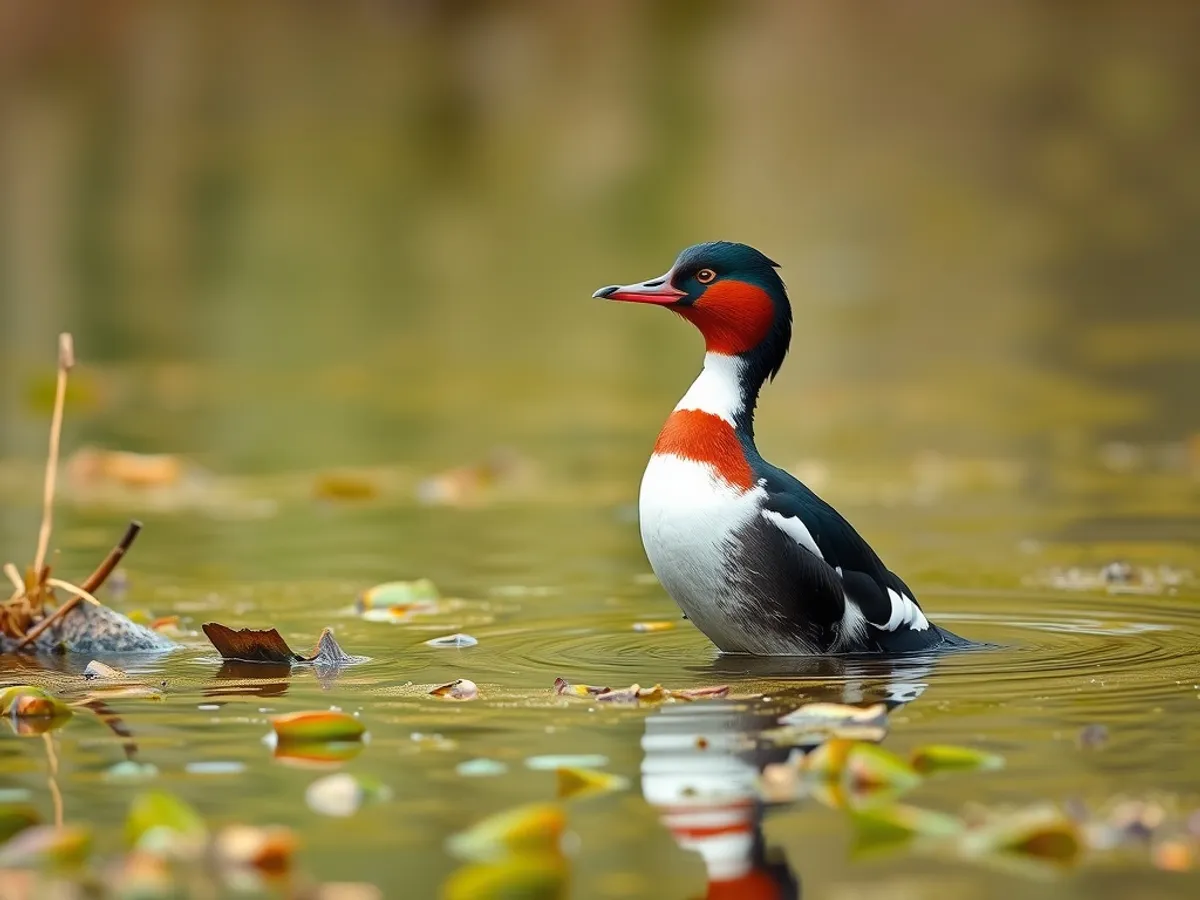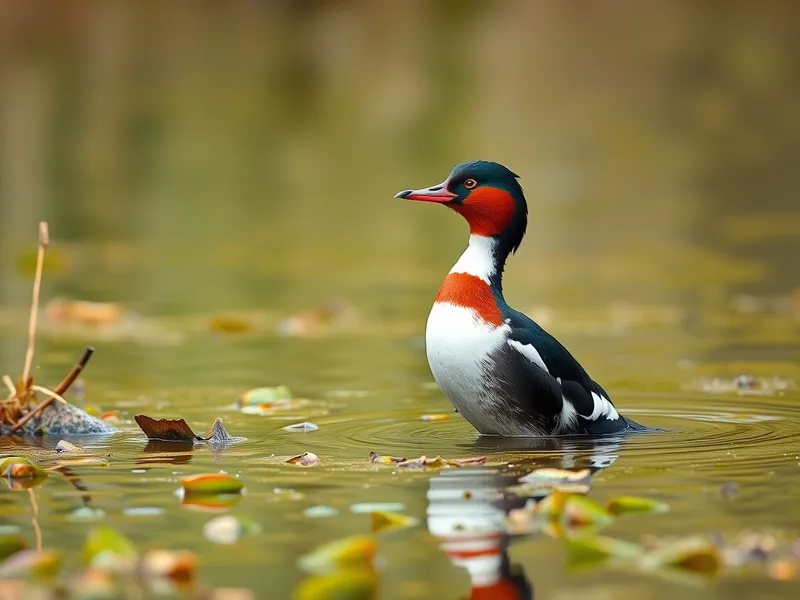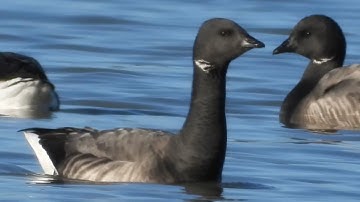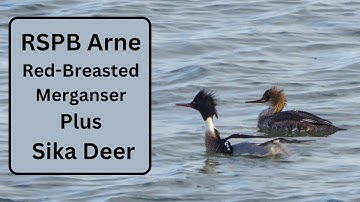
Red-breasted Merganser
Mergus serrator

Meet the Red-breasted Merganser
The Red-breasted Merganser is a striking diving duck known for its slender, serrated bill and spiky crest. Males display dramatic breeding plumage with a dark green head, rusty-red breast, and white neck ring, while females have a rusty head and grayish body. Adapted for aquatic hunting, these birds are highly agile swimmers, using their narrow bills to catch fish underwater. They breed in northern North America, Europe, and Asia, migrating to temperate coasts and large freshwater lakes during winter. The species is often seen in small flocks, especially during migration and winter months.
Classification
Bird
Habitat
Freshwater and coastal wetlands
Diet
Carnivore
Lifespan
8-13 years
Conservation
Least Concern
Weight
800-1350 g
📖Fascinating Facts
Distinctive Crest
Both male and female Red-breasted Mergansers have a shaggy, spiky crest on their heads, making them easy to identify among other ducks.
Specialized Fish Eaters
Their long, slender, serrated bills are perfectly adapted for catching and holding onto slippery fish, their primary food source.
Wide Migration Range
Red-breasted Mergansers breed in northern regions and migrate long distances, wintering along coastal waters and large inland lakes across much of the Northern Hemisphere.
📋Detailed Description
The Red-breasted Merganser (Mergus serrator) is a medium-sized diving duck, measuring 51–62 cm (20–24 in) in length with a wingspan of 66–74 cm (26–29 in), and weighing between 800–1350 g (1.8–3.0 lbs). It is distinguished by its slender, elongated body, thin serrated bill (adapted for gripping slippery prey), and a shaggy double crest on the head. Adult males in breeding plumage feature a dark iridescent green head, a sharply defined white neck collar, a reddish-brown (rusty) breast, and a gray body with black and white markings on the wings. Females and juveniles are more subdued, with a rusty-brown head, white chin patch, and grayish body. The species is highly aquatic, spending most of its life on water, and is an agile swimmer and diver. Red-breasted Mergansers are migratory, breeding in boreal and arctic regions across North America, Europe, and Asia, and wintering along temperate coastal waters, estuaries, and large inland lakes. Their diet is primarily piscivorous, but they also consume aquatic invertebrates and amphibians. Socially, they are generally seen in pairs or small groups during the breeding season, forming larger flocks during migration and winter. Their vocalizations include harsh grating calls and whistles, especially during courtship and territorial disputes. The species is well-adapted to cold environments and is capable of rapid, low flight over water, often skimming the surface.
💡 Did you know?
The Red-breasted Merganser has the fastest recorded level flight speed of any duck, clocked at 100 mph (160 km/h) by a pilot.
🔬Research & Sources
Wikipedia Summary
The red-breasted merganser is a duck species that is native to much of the Northern Hemisphere. The red breast that gives the species its common name is only displayed by males in breeding plumage. Individuals fly rapidly, and feed by diving from the surface to pursue aquatic animals underwater, using serrated bills to capture slippery fish. They migrate each year from breeding sites on lakes and rivers to their mostly coastal wintering areas, making them the only species in the genus Mergus to frequent saltwater. They form flocks outside of breeding season that are usually small but can reach 100 individuals. The worldwide population of this species is stable, though it is threatened in some areas by habitat loss and other factors.
Last Modified: 5/8/2025
🎭Behavior & Social Structure
Red-breasted Mergansers are diurnal, with peak activity at dawn and dusk. They are highly specialized pursuit divers, using their legs placed far back on the body for powerful underwater propulsion. Hunting is typically a solitary or small-group activity, though cooperative foraging has been observed, with birds herding fish into shallow waters. Their serrated bills are uniquely adapted for catching and holding slippery fish. Outside the breeding season, they are gregarious, forming loose flocks that may number up to 100 individuals, especially in rich feeding areas. During courtship, males perform elaborate displays, including head-throwing, wing-flapping, and vocalizations to attract females. Territoriality is most pronounced during the breeding season, with males defending small areas near nesting sites. Roosting occurs on water or occasionally on isolated shorelines. They are wary and quick to take flight when disturbed, often running across the water surface to gain momentum.
👶Reproduction & Life Cycle
Breeding occurs from late April to July, depending on latitude. Red-breasted Mergansers are seasonally monogamous, forming pairs during migration or shortly after arrival at breeding grounds. Nests are typically built on the ground, concealed in dense vegetation near freshwater lakes, rivers, or coastal lagoons, and sometimes in abandoned gull or crow nests. The female alone constructs the nest, lining it with down feathers. Clutch size ranges from 6 to 12 eggs, with an incubation period of 29–35 days. Only the female incubates and tends the brood. Ducklings are precocial, leaving the nest within 24 hours of hatching and are led to water by the female. The young feed themselves but remain under the mother's protection for several weeks, fledging at 60–70 days. Brood amalgamation (crèching) with other females' ducklings is occasionally observed.
🛡️Adaptations & Survival
Red-breasted Mergansers possess several specialized adaptations for aquatic predation. Their long, narrow, serrated bills function as effective tools for grasping slippery fish. Their legs are set far back on the body, enhancing diving efficiency but making terrestrial locomotion awkward. Dense, waterproof plumage and a thick layer of down provide insulation in cold water. The species has a high metabolic rate to support energetic diving and rapid flight. Their eyes are adapted for underwater vision, with a nictitating membrane protecting the eye and aiding in focus. Behavioral adaptations include migratory flexibility, allowing them to exploit a wide range of breeding and wintering habitats, and the ability to switch to invertebrate prey when fish are scarce.
🎨Cultural Significance
Red-breasted Mergansers have limited direct cultural significance but are valued by birdwatchers and naturalists for their striking appearance and dynamic behavior. In some northern cultures, mergansers have been featured in folklore as symbols of agility and resourcefulness. They are occasionally referenced in traditional art and stories in indigenous communities of the circumpolar north. Historically, their eggs and down were collected in some regions, but this is now rare. The species is sometimes cited in ecological studies as an indicator of aquatic ecosystem health due to its sensitivity to pollution and fish abundance.
🔬Recent Research & Discoveries
Recent research has focused on the species' migratory connectivity, using satellite telemetry to track long-distance movements and identify key stopover sites. Stable isotope analysis has been used to study diet and habitat use across seasons. Studies on contaminant loads have highlighted regional differences in exposure to heavy metals and persistent organic pollutants. Genetic studies indicate low differentiation across the Holarctic range, suggesting high gene flow. Ongoing research is examining the impacts of climate change on breeding phenology and range shifts. Behavioral ecologists have investigated cooperative foraging and the role of social learning in hunting efficiency.
🎥Wildlife Videos

Eight Red-breasted Mergansers
A new year's visit to Newtown NR.
Armand Sharp

A Minute of Wildlife - Red breasted Mergansers
A group of male and female Red-breasted Mergansers float on the choppy waters of a salt water bay in the cold winter waters of ...
Ray Hennessy

Mergus serrator RED-BREASTED MERGANSERS compilation 9067903
Mergus serrator RED-BREASTED MERGANSERS compilation: large female flock landing in Lake Michigan, both sexes at ...
Rob Curtis

Mergansers - hooded, common, & red-breasted
First we start off with Hooded Mergansers, and watch for the male raising his crest at around 15 seconds. -Then we are treated to ...
pHelmer in Carburn Park

Red-breasted Merganser with young
Red-breasted Mergansers with young. Part of Birds of Norway series Mountain lowlands. Scene 1.
Birding Visions | Clive Bramham

RSPB Arne - Red-Breasted Merganser and Sika Deer
Introducing Denise to a favourite venue of mine, RSPB Arne, on this first video of 2024. The “B” (for birds) in RSPB, unfortunately ...
Mark Wright
🌍Habitat Information
The Red-breasted Merganser typically inhabits Freshwater and coastal wetlands environments. Red-breasted Mergansers have adapted to their environments with specialized features and behaviors.
Primary Habitat:
Freshwater and coastal wetlands
More detailed habitat information will be available soon.
🛡️Conservation Status
The Red-breasted Merganser is currently classified as Least Concern. Conservation efforts are crucial for preserving this species for future generations.
Common Threats:
- 🏠Habitat loss and fragmentation
- 🌡️Climate change impacts
- 🎯Hunting and poaching
- 🏭Human-wildlife conflict
⚠️Threats & Conservation Challenges
While globally assessed as Least Concern by the IUCN, Red-breasted Mergansers face localized threats. Habitat loss from wetland drainage, shoreline development, and pollution (especially oil spills in coastal wintering areas) can reduce breeding and feeding sites. Overfishing and competition with commercial fisheries may limit food availability. They are vulnerable to entanglement in fishing nets and are sometimes persecuted by fishery interests due to perceived competition. Environmental contaminants, such as mercury and organochlorines, can accumulate in their tissues, affecting reproduction. Climate change poses emerging risks by altering breeding and wintering habitats. Despite these challenges, the species' wide distribution and adaptability have helped maintain stable global populations.
🔬Scientific Classification
Scientific Name
Mergus serrator
Classification Hierarchy
🔍 About Taxonomic Classification
Taxonomic classification is a hierarchical system used by scientists to classify and organize living organisms based on shared characteristics and evolutionary relationships.
The system moves from broad categories (Kingdom) to increasingly specific ones, with each animal's scientific name typically consisting of its Genus and species.
📝Community Notes
Share your observations and insights about the Red-breasted Merganser with our community of wildlife enthusiasts.
Join Our Community
Sign in to share your observations and connect with fellow wildlife enthusiasts.
Sign In to ContributeNo community notes yet
Be the first to share your observations about the Red-breasted Merganser!
Explore Red-breasted Merganser
Select a tab above to learn more about this amazing animal.
📸Photo Gallery
No photos available for this animal yet.
🌟Discover More Wildlife
Continue your journey of discovery with more fascinating animals from our database
